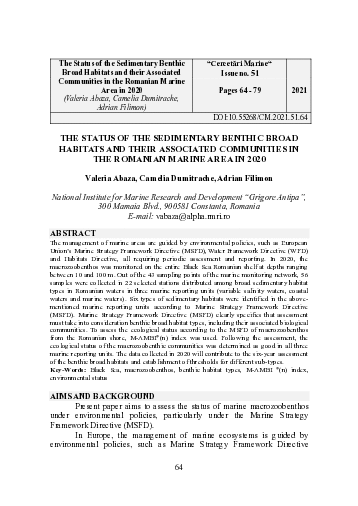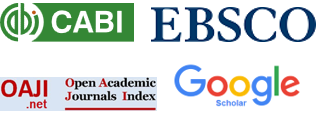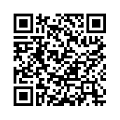The Status of the Sedimentary Benthic Broad Habitats and their Associated Communities in the Romanian Marine Area in 2020
DOI:
https://doi.org/10.55268/CM.2021.51.64Keywords:
Black Sea, macrozoobenthos, benthic habitat types, M-AMBI *(n) index, environmental statusAbstract
The management of marine areas are guided by environmental policies, such as European Union’s Marine Strategy Framework Directive (MSFD), Water Framework Directive (WFD) and Habitats Directive, all requiring periodic assessment and reporting. In 2020, the macrozoobenthos was monitored on the entire Black Sea Romanian shelf at depths ranging between 10 and 100 m. Out of the 43 sampling points of the marine monitoring network, 56 samples were collected in 22 selected stations distributed among broad sedimentary habitat types in Romanian waters in three marine reporting units (variable salinity waters, coastal waters and marine waters). Six types of sedimentary habitats were identified in the above-mentioned marine reporting units according to Marine Strategy Framework Directive (MSFD). Marine Strategy Framework Directive (MSFD) clearly specifies that assessment must take into consideration benthic broad habitat types, including their associated biological communities. To assess the ecological status according to the MSFD of macrozoobenthos from the Romanian shore, M-AMBI*(n) index was used. Following the assessment, the ecological status of the macrozoobenthic communities was determined as good in all three marine reporting units. The data collected in 2020 will contribute to the six-year assessment of the benthic broad habitats and establishment of thresholds for different sub-types.
Downloads
Published
2021-12-20
How to Cite
Abaza, V., Dumitrache, C., & Filimon, A. (2021). The Status of the Sedimentary Benthic Broad Habitats and their Associated Communities in the Romanian Marine Area in 2020. Cercetări Marine - Recherches Marines, 51(1), 64–79. https://doi.org/10.55268/CM.2021.51.64
Issue
Section
ORIGINAL ARTICLES
License
This is an open access journal, which means that all content is freely available without charge to the user or his/her institution. Users are allowed to read, download, copy, distribute, print, search, or link to the full texts of the articles, or use them for any other lawful purpose, without asking prior permission from the publisher or the author. This is in accordance with the BOAI definition of open access.






